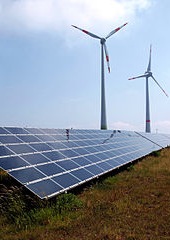Build For the Future (Part II)
Ten steps Western economies must take.
November 25, 2013

This is part two of a three-part series on the need for the western economies to embark on fundamental reforms.
The Western world needs to step up its game to support future economic growth. Only by doing so will it be possible to deal with the debt overhang and the financial implications of an aging society. First steps presented in Part I have to include investments in education and capital stock, later retirement and higher workforce participation of women.
Next steps must focus on immigration policy, the efficiency of government and of raw materials, and cooperation on a global basis.
4. Develop smart immigration policy
Even if developed countries take all of the prior three steps, it will still not be enough to reverse the prevailing demographic trend. Therefore, we also need to become far more open to and attractive to immigrants.
With the oldest native population and an immigrant population close to zero, Japan faces the most severe challenge. Germany also struggles to attract well-educated immigrants due to the language barrier.
Although immigration to Germany has increased since the financial crisis, most of this immigration is from countries in southern Europe such as Greece, Portugal and Spain. Such internal eurozone migration only serves to weaken the economies of these periphery countries still further.
And whatever economic benefits Germany gains from these new migrants will likely be cancelled out by the higher transfer payments that will be necessary to keep the weak economies in the eurozone periphery from collapsing. From a Europe-wide perspective, attracting immigration from outside of Europe has to be the goal.
The United States, which has long prided itself on being a “nation of immigrants,” needs to revise its immigration policies. Since World War II, the U.S. system of higher education has attracted the world’s best students and the United States has benefitted economically from their presence.
For every one-percentage point increase in foreign students in the United States, there has been an increase in patents in the neighborhood of 9 to 18%. Immigrant entrepreneurs have played a central role in U.S. technological innovation, most notably in Silicon Valley. There, more than half of the start-ups are founded or co-founded by Indian or Chinese entrepreneurs.
Since 9/11, the United States has become far more restrictive with regard to immigration and work visas, while emerging markets have gained in attractiveness. As a result, a much higher share of foreign students is returning to their countries of origin.
According to one survey of foreign graduates, “fewer than 10% of Indians and Chinese ‘strongly’ desire to stay in the U.S.” Note that the developed economies compete against each other and with the emerging markets for the same limited talent pool.
Immigration should focus on attracting well-educated and highly motivated people who want to build their own life in their new home country and contribute to economic growth there. Canada is a good model. There, a full 20% of permanent residents are foreign born and immigration enjoys widespread public support.
Canadian immigration policy is highly selective, attracting skilled individuals who will improve the human capital base. Effective integration programs and the principle of permanent migration, which gives both immigrants and the receiving society a stake in favorable long-term outcomes, ensure the success and make Canada attractive for talent from all over the world.
The countries of the West compete with each other and the emerging markets for the talent of the world. Only those that are attractive to the best will be in a position to generate the innovations necessary and build the industries of the future.
The United States is still best positioned to benefit from this trend, but other nations are gaining momentum. Europe needs an answer to its need for qualified immigration and for the unqualified potential of immigrants at is shore.
5. Increase the efficiency of government
The government’s share in the economy, measured in terms of government spending as a share of GDP, has a negative impact on economic growth. An increase in government size of 10 percentage points is associated with a lower growth rate of between 0.5 – 1%.
In most European countries, government spending is currently about 40% of GDP or more, with some countries such as France and Denmark reaching nearly 60%. Even the United States now has a share of 40%. By contrast, developing economies have a share of government ranging between 20 and 40%.
Increasing the efficiency of the welfare systems
Increasing the efficiency of the welfare systems is one area ripe for rationalization. One change to consider is to replace traditional means testing, which can become highly bureaucratic and resource-intensive very quickly, with a guaranteed minimal income.
This idea has been supported in the past by liberals such as Martin Luther King and John Kenneth Galbraith, but also by conservatives such as Friedrich Hayek, Richard Nixon and Milton Friedman. A guaranteed minimal income has the advantage of eliminating most procedures for means testing and frees up resources traditionally used in the allocation and distribution of those funds.
Free up the public sector workforce for effective use
It is also important to reduce the number of public employees as a percentage of the overall population. In a period when labor will become increasingly scarce, it is critical that as many people as possible actually generate GDP (rather than merely consuming and redistributing it).
This is not to say that public service employees do not contribute to the overall welfare of society. But in a world of scarcity, the trade-offs become more visible. And government inefficiencies are significant, especially in European countries. Just imagine — France has double the number of public servants per inhabitant as Germany! Being a German, I can assure you I do not feel “underserved.”
Maximize the economic potential of the economy
Besides reforming social welfare and retirement systems, it is important to maximize the economic potential of the economy. Therefore, efforts to increase competition by abolishing rules that block new entrants and to increase the flexibility of labor markets need to be implemented fast. According to a study by the IMF, the growth potential of economies in Western Europe could be increased by 4.5% over 5 years through the adoption of such measures.
A smaller government sector does not necessarily mean a weaker government. By defining the right “rules of the road” for society and business, the government can set the tone and the priorities for the development of a society in a more effective as well as more efficient way.
6. Increase raw-material efficiency
The speed of economic development in the emerging markets and the sheer number of people aspiring to a developed-world life style will lead to structurally higher raw material prices. Efforts to reduce energy consumption and CO2 emissions to preserve the environment will lead to higher costs as well.
The availability of cheap natural resources, which for more than a century has been an enabler of productivity improvement, may be disappearing. Developed countries have to increase their efforts to decouple economic development from resource consumption.
Support alternative energy technologies
Support alternative energy technologies: Although almost half of new power capacity added in 2011 worldwide was in renewables, the share of fossil fuels in total power generated is still around 80%. And with the discovery of new techniques for exploiting fossil fuels like shale gas, the temptation will be slow to transition to renewables. But such traditional solutions will only be temporary.
The transition to renewables needs to be accelerated by governments through investments in national infrastructure and innovative pilot projects. Because of their very long investment time horizons, ambitious and highly innovative projects such as Desertec (solar power plants in northern Africa to supply energy to Europe) or Masdar (a zero-waste, zero-carbon city for 40,000 citizens in the United Arab Emirates) rely on public funding.
Promote material-efficient production and products
With rising energy and raw material prices, it is a strategic priority for businesses to continuously improve the production efficiency of their supply chains. Furthermore, companies need to invest in material-efficient products in order to satisfy changing consumer demand. Politicians should put in place effective policies so that efficient technologies are developed and applied by companies and consumers.
It does not matter whether someone believes in climate change or not. Reducing the raw material and energy intensity of an economy equals cost cutting in a corporation. It frees up resources for other purposes like innovation and investments in capital stock — and more consumption.
7. Cooperate on a global basis
Competition among countries will become more intense in the years to come. All countries will try to increase their exports. All will try to attract the best immigrants. All will try to secure scarce resources from water to oil to commodities.
This increased competition will pay dividends in the form of new and innovative products. But even as they compete, the world’s countries must also cooperate. The problems of the developed economies can only be addressed in a cooperative way on a global scale. Otherwise, the world risks descending into a vicious circle of beggar-thy-neighbor economic policies leading to much lower growth and slower improvement of living conditions worldwide.
Help debtors pay back their debts
In recent decades emerging-market countries have become significant creditors for the developed world. China alone holds almost $1.3 trillion in U.S. Treasury bonds. And according to one investment research firm, it also had an estimated €500 billion to €600 billion in European sovereign debt in 2011.
The creditors have to help the debtors pay back their debts. This requires the deficit countries to run a trade surplus and the former surplus countries to run a deficit.
The emerging economies need to adjust their business model, focusing less on export-based growth and more on domestic consumption. These countries might also support economic adjustment in the developed economies by participating in efforts to reduce the debt overhang in an orderly way through restructurings and redemption funds.
Reduce energy and commodity intensity
Support efforts to reduce energy and commodity intensity. Any efforts to become more efficient in the use of energy and other commodities would dampen the price pressures, greatly improve economic growth and support the adjustment process.
According to the International Energy Agency, if effective policies are put in place to realize the potential of all economically viable energy efficiency measures known today, growth in global primary energy demand could be halved by 2035 and cumulative economic output boosted by $18 trillion.
The worst-case scenario is a world of isolationism and beggar-thy-neighbor policies. Only by cooperating can the developing world continue to improve its living standards and can the West preserve its existing lifestyle. Right now we see worrying signals as trade imbalances remain and countries like Japan try to resolve their own issues by aggressive devaluation.
Takeaways
With the oldest native population and an immigrant population close to zero, Japan has a severe immigration challenge.
Immigration to Germany has increased but is mostly from southern Europe, which weakens those economies.
Every one-percentage point increase in foreign students in the US has brought an increase in patents of 9 to 18%.
In Silicon Valley, more than half of the start-ups are founded or co-founded by Indian or Chinese entrepreneurs.
A survey of foreign graduates showed that fewer than 10% of Indians and Chinese strongly desire to stay in the US.
Canadian immigration policy is selective, attracting skilled individuals to improve the human capital base.
An increase in government size of 10 percentage points is associated with a lower growth rate of 0.5 to 1%.
European governments’ spending is about 40% of GDP and as high as nearly 60%. The US now has a share of 40%.
Developing economies governments’ spending ranges between 20 and 40% of GDP.
In the past, liberals and conservatives have supported a guaranteed minimal income.
It is critical that as many people as possible actually generate GDP.
Western Europe could grow by 4.5% over 5 years by admitting new entrants and increasing labor market flexibility.
A smaller government sector does not necessarily mean a weaker government.
Developed countries have to increase their efforts to decouple economic development from resource consumption.
China holds $1.3 trillion in U.S. Treasury bonds and held €500 - €600 billion in European sovereign debt in 2011.
The worst-case scenario is a world of isolationism and beggar-thy-neighbor policies.
Read previous

Build For the Future
November 25, 2013
